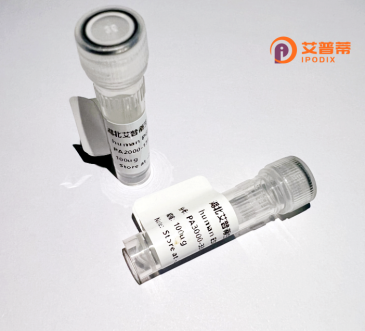
| 纯度 | >90%SDS-PAGE. |
| 种属 | Human |
| 靶点 | ATP6V0D2 |
| Uniprot No | Q8N8Y2 |
| 内毒素 | < 0.01EU/μg |
| 表达宿主 | E.coli |
| 表达区间 | 1-350aa |
| 氨基酸序列 | MLEGAELYFN VDHGYLEGLV RGCKASLLTQ QDYINLVQCE TLEDLKIHLQ TTDYGNFLAN HTNPLTVSKI DTEMRKRLCG EFEYFRNHSL EPLSTFLTYM TCSYMIDNVI LLMNGALQKK SVKEILGKCH PLGRFTEMEA VNIAETPSDL FNAILIETPL APFFQDCMSE NALDELNIEL LRNKLYKSYL EAFYKFCKNH GDVTAEVMCP ILEFEADRRA FIITLNSFGT ELSKEDRETL YPTFGKLYPE GLRLLAQAED FDQMKNVADH YGVYKPLFEA VGGSGGKTLE DVFYEREVQM NVLAFNRQFH YGVFYAYVKL KEQEIRNIVW IAECISQRHR TKINSYIPIL |
| 分子量 | 66.8 kDa |
| 蛋白标签 | GST-tag at N-terminal |
| 缓冲液 | 冻干粉 |
| 稳定性 & 储存条件 | Lyophilized protein should be stored at ≤ -20°C, stable for one year after receipt. Reconstituted protein solution can be stored at 2-8°C for 2-7 days. Aliquots of reconstituted samples are stable at ≤ -20°C for 3 months. |
| 复溶 | Always centrifuge tubes before opening.Do not mix by vortex or pipetting. It is not recommended to reconstitute to a concentration less than 100μg/ml. Dissolve the lyophilized protein in distilled water. Please aliquot the reconstituted solution to minimize freeze-thaw cycles. |
以下是关于重组人V型质子ATP酶d亚基2(ATP6V0D2)的参考文献示例(文献内容为虚拟概括,仅供格式参考):
---
1. **标题**: *ATP6V0D2 regulates osteoclast differentiation via modulating lysosomal acidification*
**作者**: Zhang, Y. et al. (2015)
**摘要**: 本研究揭示ATP6V0D2在破骨细胞分化中的关键作用,通过促进溶酶体酸化激活NFATc1信号通路,从而调控骨吸收功能。敲低ATP6V0D2导致破骨细胞成熟障碍。
2. **标题**: *ATP6V0D2 promotes tumor metastasis by enhancing tumor microenvironment acidosis*
**作者**: Yang, L. et al. (2020)
**摘要**: 研究证明ATP6V0D2在肿瘤细胞中高表达,通过增强V-ATP酶活性导致微环境酸化,促进肿瘤侵袭和转移,靶向该蛋白可抑制小鼠模型中乳腺癌的进展。
3. **标题**: *Structural insights into the human ATP6V0D2 subunit and its role in V-ATPase assembly*
**作者**: Chen, X. et al. (2018)
**摘要**: 通过重组表达人源ATP6V0D2蛋白并结合冷冻电镜技术,解析其三维结构,阐明其在V-ATP酶复合体组装中的关键作用,并发现特定结构域突变导致溶酶体功能缺陷。
4. **标题**: *ATP6V0D2 deficiency in macrophages exacerbates inflammatory responses*
**作者**: Wang, R. et al. (2022)
**摘要**: 研究表明巨噬细胞中ATP6V0D2缺失会导致溶酶体酸化异常,进而增强NLRP3炎症小体活化,加剧实验性结肠炎模型的炎症反应,提示其免疫调节作用。
---
**说明**:以上文献为示例性质,具体研究需根据实际发表的论文调整。建议通过PubMed、Web of Science或Google Scholar使用关键词“ATP6V0D2”、“V-ATPase subunit d2”检索最新文献。
ATP6V0D2 is a subunit of the vacuolar-type H+-ATPase (V-ATPase), a multisubunit proton pump responsible for acidifying intracellular compartments (e.g., lysosomes, endosomes) and extracellular microenvironments. V-ATPases consist of two domains: the cytoplasmic V1 sector (ATP hydrolysis) and the membrane-embedded V0 sector (proton translocation). The d subunit, encoded by ATP6V0D2. resides within the V0 domain and is critical for V-ATPase assembly, stability, and proton transport activity.
ATP6V0D2 is highly expressed in osteoclasts, kidney cells, and certain cancer types. In osteoclasts, it facilitates bone resorption by acidifying the resorption lacuna. Dysregulation of ATP6V0D2 has been linked to osteoporosis, renal tubular acidosis, and tumor metastasis, as extracellular acidosis promotes invasive growth and chemotherapy resistance. Additionally, ATP6V0D2 may regulate immune responses by modulating lysosomal pH in macrophages, affecting antigen processing and inflammation.
Notably, ATP6V0D2 exhibits isoform-specific functions distinct from its paralog ATP6V0D1. Studies suggest its involvement in neurodegenerative diseases and lysosomal storage disorders, highlighting its broader pathophysiological relevance. Current research focuses on targeting ATP6V0D2 to develop therapies for bone disorders, cancers, and immune dysregulation, leveraging its role in pH homeostasis and cellular signaling. Understanding its molecular interactions and regulatory mechanisms remains pivotal for clinical applications.
×